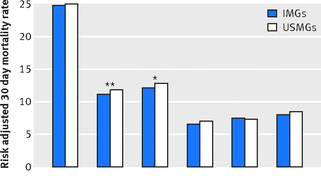Patients treated by foreign-educated doctors have lower 30-day mortality rates than patients treated by U.S.-trained doctors, says a study by Boston-area researchers published in The BMJ, formerly known as the British Medical Journal. The majority of foreign-born doctors work in rural and underserved areas. (Mortality rates for patients of U.S. and internationally trained doctors)
The study looked at 1,215,490 hospital admissions from 2011-14 of Medicare fee-for-service beneficiaries 65 and older treated by 44,227 general internists, about 44 percent of whom were educated outside the U.S. "After adjustment for patient and physician characteristics and hospital fixed effects, patients treated by international graduates had lower mortality," 11.2 percent to 11.6 percent. Average costs were higher for patients of international doctors, $1,145 to $1,098 and readmission rates were similar for all patents.
While the difference in mortality rates—11.2 percent to 11.6 percent—might not seem like a lot, "it’s nearly 5,000 additional deaths," Katherine Ellen Foley reports for Quartz. "Another way to look at it: immigrant doctors save one additional life for every 250 patients treated than U.S.-trained docs."
"The authors suspect the differences in care are due to a higher bar for employment for foreign doctors in the U.S.," Foley writes. "Only about half of foreign doctors who apply for positions in the U.S. get them, and they must undergo a residency in America—even if they’ve done one elsewhere already. They also have to take three additional exams assessing their medical knowledge and clinical capabilities."
Foreign-born doctors are more likely to treat patients who are less likely to be white, affluent or covered by private insurance, Lisa Rapaport reports for Reuters. "Patients seen by international doctors were also more likely to have multiple chronic health problems like congestive heart failure, diabetes and chronic obstructive pulmonary disease."
The study looked at 1,215,490 hospital admissions from 2011-14 of Medicare fee-for-service beneficiaries 65 and older treated by 44,227 general internists, about 44 percent of whom were educated outside the U.S. "After adjustment for patient and physician characteristics and hospital fixed effects, patients treated by international graduates had lower mortality," 11.2 percent to 11.6 percent. Average costs were higher for patients of international doctors, $1,145 to $1,098 and readmission rates were similar for all patents.
While the difference in mortality rates—11.2 percent to 11.6 percent—might not seem like a lot, "it’s nearly 5,000 additional deaths," Katherine Ellen Foley reports for Quartz. "Another way to look at it: immigrant doctors save one additional life for every 250 patients treated than U.S.-trained docs."
Foreign-born doctors are more likely to treat patients who are less likely to be white, affluent or covered by private insurance, Lisa Rapaport reports for Reuters. "Patients seen by international doctors were also more likely to have multiple chronic health problems like congestive heart failure, diabetes and chronic obstructive pulmonary disease."

No comments:
Post a Comment